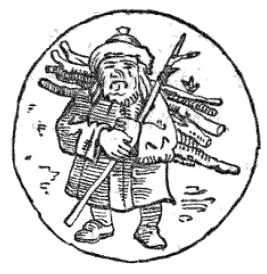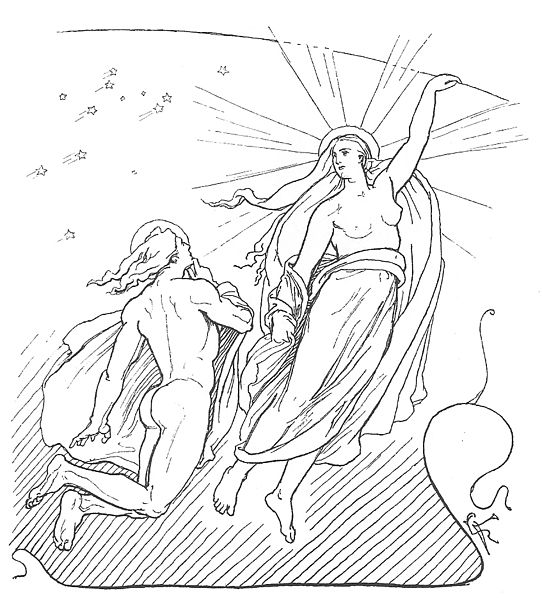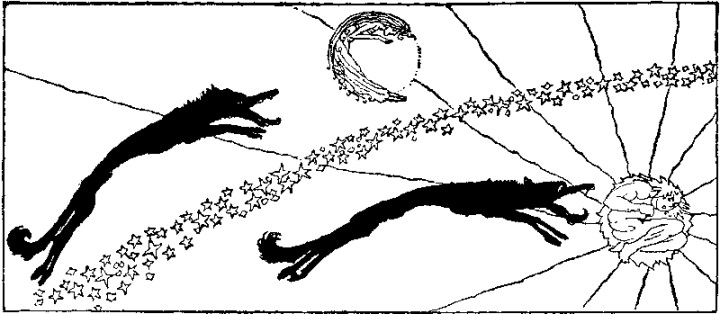Norse mythology, a tapestry of tales woven from the cold lands of Scandinavia, is filled with gods and creatures of immense power and mystery. Among these deities, Máni, the moon god, shines brightly, casting his luminous glow over the Norse cosmos. His significance as the moon deity is not just about illuminating the night sky but also about the myths and legends that revolve around him.
Máni Key Facts
| Parents | Mundilfari |
| Partners | None known |
| Siblings | Sól ( the sun goddess) |
| Offspring | None known |
| Tribe | Aesir |
| Old Norse name | Máni |
| Other names | Waxer, Waner, Year-teller, and more |
| The God of | Moon |
| Ass. Animal | Horses pulling his chariot |
Name and Etymology
In Old Norse, Máni directly translates to “moon,” which is pretty straightforward, he is the personification of the moon. Names in Norse mythology often have a deeper meaning or connection to the deity’s role or essence, and Máni is no exception.
In the Skaldskaparmal, chapter LV (55), several kennings and names for the Moon are listed. These include: Moon, Waxer, Waner, Year-Teller, Mock-Sun, Fengari, Glamour, Haster, Crescent, and Glare. Each of these names offers a unique perspective on the moon’s attributes and its significance in Norse culture.
In another source, the poem Alvíssmál, Thor questions the dwarf Alvíss about the various names for the Moon across different worlds. Alvíss provides a fascinating list: it’s called “moon” by humans, “fiery one” by the gods, “the whirling wheel” in Hel, “the hastener” by the jötnar (giants), “the shiner” by the dwarves, and “the counter of years” by the elves.
This diversity in naming highlights the moon’s universal importance across various realms and beings in Norse mythology.
Ancient roots
The name “Máni” can be traced back to the Proto-Germanic word *mēnô, which means “moon.” This Proto-Germanic root is the ancestor of the modern English word “moon” and the German word “Mond.” It’s intriguing to see how languages evolve over time, yet some words, especially those tied to nature or celestial bodies, retain a core essence that transcends time and borders.
So, while “Máni,” “moon,” and “Mond” might sound different, they all share the same ancient root, highlighting the interconnectedness of languages and cultures. In modern Norwegian, it is Måne, so while we do use that fancy “å” it’s still quite close even today.
Máni’s Origins
Máni’s story is deeply rooted in Norse mythology, with references found in both the Poetic Edda and the Prose Edda. These texts, compiled and written in the 13th century, provide a wealth of information about the Norse pantheon and its intricate tales.

Born to Mundilfari, Máni shares a special bond with his sister, Sól, who personifies the sun. Together, they represent the celestial balance of day and night in the Norse cosmos. Their relationship is a testament to the interconnectedness of light and darkness, and the roles they play in the grand tapestry of Norse myths.
Now, when we talk about Máni’s “family,” there’s an interesting twist. While traversing the heavens, Máni is accompanied by two children, Hjúki and Bil. However, it’s essential to note that these children aren’t his direct offspring. Instead, they’re more like adopted companions. The exact nature of their relationship and how they came to accompany Máni is a tale in itself, but their presence adds another layer to Máni’s character.
Roles And Depiction
In the Norse pantheon, Máni isn’t just a celestial body shining in the night sky; he holds a much deeper significance. The moon, with its predictable phases, was a crucial tool for the Norse people in tracking time. This seems to have been the case both for a lunar month and a year. Interestingly, shorter time was often counted in the number of nights, rather than days.
Imagine living in a time without digital clocks or calendars. For the Norse, the moon’s cyclical journey across the sky provided a natural calendar. Its waxing and waning phases helped them gauge the passage of days, while the full moon marked specific points in a month. Over longer periods, the moon’s cycles played a role in determining the seasons, which was vital for agriculture, hunting, and other activities.
Furthermore, Máni’s consistent presence and predictable patterns made him a symbol of reliability. His journey was not just about illuminating the night but also about providing a sense of order and predictability in a world filled with uncertainties. To the Norse people, Máni was both a guide and a guardian, helping them navigate through the challenges of life with the assurance that he would always be there, marking time and guiding their way.
Myths about Máni
Máni, the Norse god of the moon, has been a central figure in several myths that shed light on his origins, his interactions, and his eventual fate. Let’s delve into three of the most significant tales associated with him.
The Origins of Máni and His Sister Sól

According to the poem Völuspá from the Poetic Edda, in the early days of the universe, the sun and the moon didn’t know their places in the cosmos. The sun, referred to as the sister of the moon, and the moon itself, wandered without knowing their true purpose or power. It was only later, as mentioned in Vafþrúðnismál, that we learn of their parentage. A figure named Mundilfari had two children so radiant and beautiful that he named them after the celestial bodies: Sól (Sun) and Máni (Moon). This act of naming them was perceived as hubris by the gods. Angered by Mundilfari’s audacity, the gods placed the siblings in the heavens. Moreover, assigning them their eternal roles of governing moon and the sun..
The Tale of Hjúki and Bil
In the Prose Edda’s Gylfaginning, there’s a captivating tale about Máni and two children, Hjúki and Bil. These siblings were fetching water from a well when Máni, taken by their presence, took them from Earth. As they journey with him, they can be seen from our planet, following Máni through the heavens. Some scholars believe that this myth was an ancient way to explain the moon’s phases, with Hjúki and Bil symbolizing the waxing and waning of the moon.
Máni’s Fate at Ragnarök
Ragnarök, the prophesied end of the world in Norse mythology, spells doom for many gods, and Máni is no exception. As foretold in Grímnismál, giant wolves chase both the sun and the moon. While Hati Hróðvitnisson pursues the sun, it’s Sköll who chases after Máni. In the grim events of Ragnarök, Máni meets his tragic end when he is finally consumed by Sköll. This event marks one of the many cataclysms that befall the Norse cosmos during Ragnarök.
Play Fun Norse Quiz
Is this article making you even more curious about Norse gods and goddesses? You can satisfy your curiosity by playing a fun Norse mythology quiz. This way, you can test your knowledge about Norse gods and goddesses, as well as fill in some gaps. Good luck and have fun playing!
Don’t forget to try our other games as well!
Compared with the Greek Moon Goddess Selene
Máni and the Greek moon goddess Selene both reign over the moon in their respective mythologies. However, their depictions and stories differ in intriguing ways. For starters, Máni is a god, while Selene is a goddess. Indeed a contrast that offers unique perspectives on how different cultures perceive lunar deities. However, they also share similarities; both are often depicted as driving chariots across the night sky, illuminating the world below.
Mentions in Ancient Texts
Mani is mentioned many times in ancient texts, providing invaluable insights into the tales and significance of the moon god. These texts offer a window into the beliefs, stories, and reverence the Norse people held for the celestial bodies. Let’s delve into these mentions and explore the luminous presence of Máni in these ancient writings.
Poetic Edda

Völuspá
In the poem Völuspá, a deceased völva recounts the universe’s history and foretells the future to the disguised god Odin. This poem provides insights into the early days of the universe:
Benjamin Thorpe translation:
“The sun from the south, the moon’s companion, her right hand cast about the heavenly horses Arvak and Alsvid. The sun knew not where she a dwelling had, the moon knew not what power he possessed, the stars knew not where they had a station.”
Henry Adams Bellows translation:
“The sun, the sister of the moon, from the south Her right hand cast over heaven’s rim; No knowledge she had where her home should be, The moon knew not what might was his, The stars knew not where their stations were.”
Vafþrúðnismál
In this poem, Odin questions the jötunn Vafþrúðnir about the Sun and Moon’s origins. Vafþrúðnir reveals that Mundilfari is the father of both Sól and Máni:
“Mundilfæri hight he, who the moon’s father is, and eke the sun’s; round heaven journey each day they must, to count years for men.”
Grímnismál
Odin mentions that both the Sun and the Moon are pursued through the heavens by wolves:
“The Sun, referred to as the ‘shining god’, is pursued by Sköll to the ‘protecting woods’, while the moon is pursued by Hati Hróðvitnisson.”
Alvíssmál
Thor questions the dwarf Alvíss about the Moon’s names across different worlds:
Prose Edda
Gylfaginning
In the Gylfaginning section of the Prose Edda, Máni is mentioned in three chapters. One notable mention is when High says:
“Máni and his sister Sól are the children of a man by the name of Mundilfari. The children were so fair that Mundilfari named them ‘moon’ and ‘sun’. Máni ‘guides the path of the moon and controls its waxing and waning.'”
Furthermore, Máni is followed by the children Hjúki and Bil, whom he took from Earth.
Skáldskaparmál
In Skáldskaparmál, names are provided for the Moon:
“lune”, “waxer”, “waner”, “year-counter”, “clipped”, “shiner”, “gloam”, “hastener”, “squinter”, and “gleamer”.
Frequently Asked Questions
Featured Image Credit: John Charles Dollman, Public domain, via Wikimedia Commons
